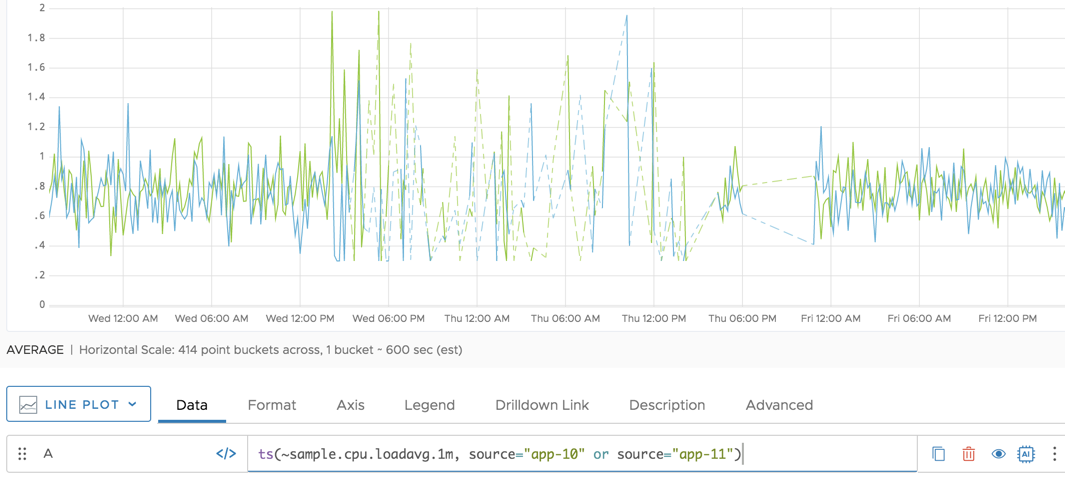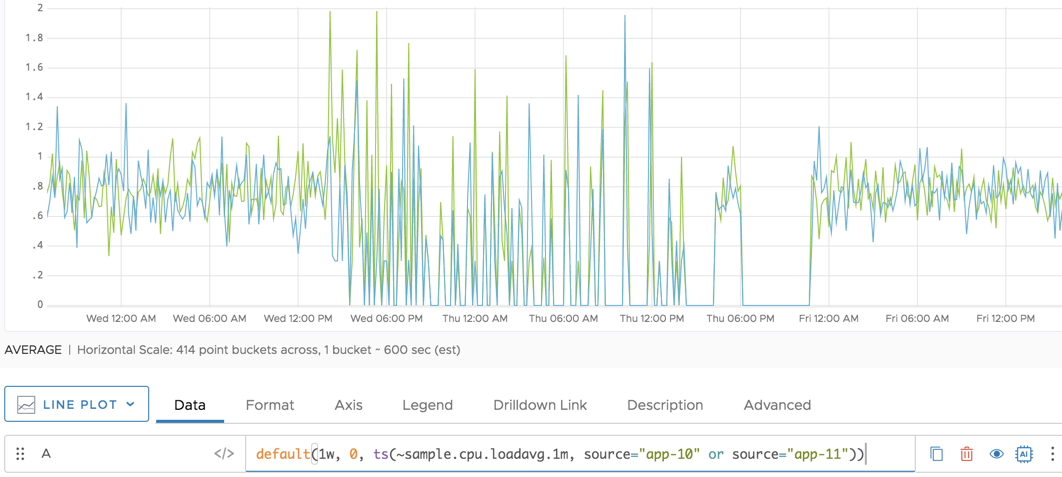Summary
default([<timeWindow>,] [<delayTime>,] <defaultValue>, <tsExpression> [.orElse<defaultIfNoData>])
Fills in gaps in the time series described by tsExpression, by inserting data points with the value defaultValue.
- Specify
timeWindowto fill in data for just a limited period of time after each existing point. - Specify
delayTimeto allow a gap before the inserted data.
timeWindow, we apply the default value for every second and fill gaps up to 28 days. Performance of queries and dashboards can deteriorate.default() function is one of the most misunderstood functions in Wavefront Query Language (WQL). See the Caveats section below for recommendations.Parameters
| Parameter | Description |
|---|---|
| timeWindow | Maximum amount of time to fill with inserted data points. If you omit this parameter, gaps with duration of up to the metrics obsolescence period are completely filled.
You can specify a time measurement based on the clock or calendar (1s, 1m, 1h, 1d, 1w), the window length (1vw) of the chart, or the bucket size (1bw) of the chart. Default is minutes if the unit is not specified. |
| delayTime | Amount of time that must pass without a reported value before inserting data points. If you omit this parameter, data points are inserted at the beginning of each gap. The delayTime affects the timeWindow. For example, if you provide a default value of 5 min but start after a 1 min delay, only the last 4 min of that time window are populated with the default value. |
| defaultValue | Value that you want to use in places where there are gaps in the data. You can specify a constant or a function that returns time series. |
| tsExpression | Expression in which you want to replace gaps in data with a default value. |
| .orElse | An optional operator that allows you to specify a default value even if the time series did not report any data in the specified time window. You can enter a constant value, for example orElse(5). You can also enter a timeseries for chained .orElse statements, for example .orElse(ts('my.metric')). |
Description
The default() function allows you to specify the value that you would like to assign to gaps of missing data on a chart. This is the only missing data function that allows you to specify the value you’d like to assign to gaps of missing data. The default() function only fills the gaps after a data point, not after a given timestamp.
Basic Usage
For the simplest case, you can use default() to set the default value of a query to 0 if the specified metric does not exist:
default(0, ts(my.metric))
default(). See the list of Caveats below. In that case, use the following query instead.ts(my.metric).orElse(0)
Using default() With .orElse
While the default() function allows you to specify a value for missing points on a chart, the function shows NO DATA if the time series reported no data at all in the specified time window. In that situation, you can use default() with the .orElse operator to specify a value to return if no data are found.
orElse is together with default() but you can use .orElse with other functions.Examples
Examples for Basic Usage of default()
The first screenshot shows two time series. The lines are dashed when there are no data:

If we wrap default() and specify 0 as the default, missing data are replaced with 0 in the display.

Examples for default() with .orElse
- If the time series exists in the time window,
default()fills in the values and.orElseis not needed (does nothing).default(100, ts('my.metric').orElse(25)) - If the time series does not exist in the time window, i.e. is not reporting in the past four weeks, NO DATA is shown by default. However,
.orElsespecifies a value of 25, which is shown for the time series.default(100, ts('metric_not_there').orElse(25))
Caveats
Use default() with care:
- Sometimes using
default()is just what you need - but sometimes it does not behave the way you might expect. - In many cases
default()does not add value when used with alerts. default()can affect performance - and in some cases prevent alerts from firing.
Here are some things to watch out for – and suggestions how you can rewrite the query without using default() in many cases:
Time Series Churn with default()
Use of default() leads to slower queries if there’s time series churn, that is, old time series stop reporting and new time series start reporting all the time. This can happen easily if sources are dynamically provisioned, for example, in case of an EC2 instance.
For example, consider the following query:
align(1m, default(0, ts("filehandles.used"))) / align(1m, default(0, ts("filehandles.total"))) * 100 > 60.
Assume your environment has about 350 active time series at any moment, but within the last 2 weeks (the metrics obsolescence period if the default configuration is not changed), ~7200 unique time series were active.
In this case, default() is not needed at all - filehandles.used and filehandles.total always report together. The following query is more than 20x faster:
ts("filehandles.used") / ts("filehandles.total") * 100 > 60
Alerts Don’t Fire with default()
When a metric arrives with a delay of more than 1 minute, the use of default() can prevent an associated alert from firing because the value for the last minute evaluates to false.
Instead of accounting for sparse metrics – success.count is reporting all the time, but failure.count is reporting a value only when there’s a problem – approach the query from a different angle.
Instead of:
ts(success.count) * 100 / (default(0, ts(failure.count)) + ts(success.count)) < 95
Use
ts(failure.count) * 100 / (ts(failure.count) + ts(success.count)) > 5
Unexpected Behavior with highpass() and default()
Using highpass() after default() with a higher highpass value than default reverts the effects of default().
Instead of
highpass(..., default(0, ts(...)))
Use
highpass(..., ts(...))
Using msum() Makes default() Redundant
Using msum() after default(0, ) is redundant because msum() always returns a value for all active series where default(0, ) backfills a value.
Instead of
msum(..., default(0, ts(...)))
Use
msum(..., ts(...))
Using rawsum() Makes default() Redundant
Using rawsum() after default(0, ) is usually redundant. If you are sure that default() is necessary:
Instead of
rawsum(default(0, ts(...)))
Use
default(0, rawsum(ts(...)))
Time Windows and default()
To improve performance, limit the time window.
- Use the timeWindow parameter to limit to the current time window.
- Use the delayTime parameter introduce a delay time.
Histogram and default()
You cannot apply default() to a histogram. Even if you convert the histogram to a tsExpression, an error results if you then apply default().
See Also
Using Moving and Tumbling Windows to Highlight trends
Other missing data functions include: